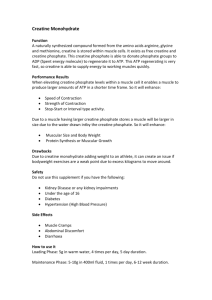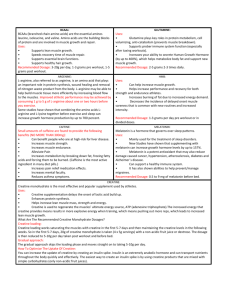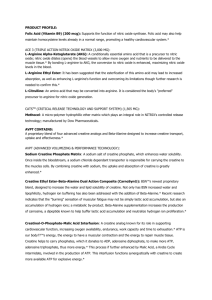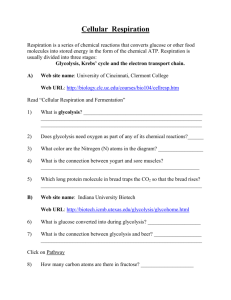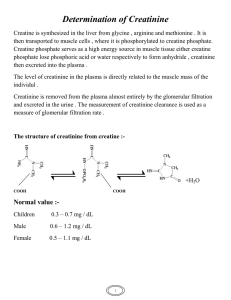Disorders of Creatine Metabolism 24
advertisement
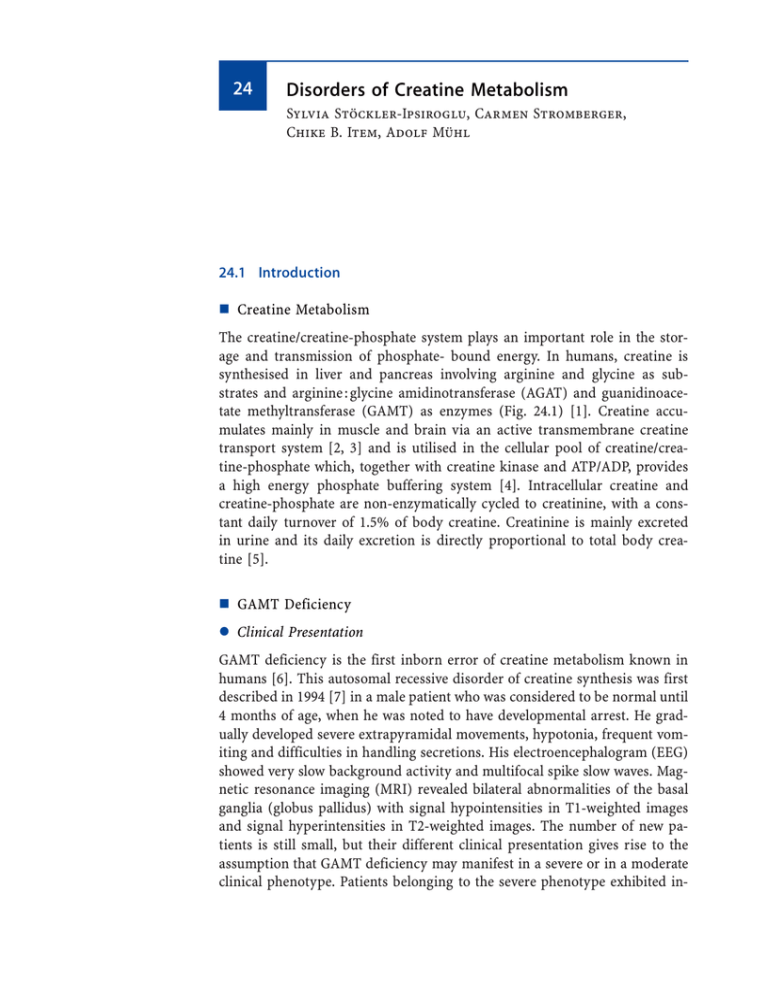
24 Disorders of Creatine Metabolism Sylvia Stöckler-Ipsiroglu, Carmen Stromberger, Chike B. Item, Adolf Mühl 24.1 Introduction n Creatine Metabolism The creatine/creatine-phosphate system plays an important role in the storage and transmission of phosphate- bound energy. In humans, creatine is synthesised in liver and pancreas involving arginine and glycine as substrates and arginine : glycine amidinotransferase (AGAT) and guanidinoacetate methyltransferase (GAMT) as enzymes (Fig. 24.1) [1]. Creatine accumulates mainly in muscle and brain via an active transmembrane creatine transport system [2, 3] and is utilised in the cellular pool of creatine/creatine-phosphate which, together with creatine kinase and ATP/ADP, provides a high energy phosphate buffering system [4]. Intracellular creatine and creatine-phosphate are non-enzymatically cycled to creatinine, with a constant daily turnover of 1.5% of body creatine. Creatinine is mainly excreted in urine and its daily excretion is directly proportional to total body creatine [5]. n GAMT Deficiency l Clinical Presentation GAMT deficiency is the first inborn error of creatine metabolism known in humans [6]. This autosomal recessive disorder of creatine synthesis was first described in 1994 [7] in a male patient who was considered to be normal until 4 months of age, when he was noted to have developmental arrest. He gradually developed severe extrapyramidal movements, hypotonia, frequent vomiting and difficulties in handling secretions. His electroencephalogram (EEG) showed very slow background activity and multifocal spike slow waves. Magnetic resonance imaging (MRI) revealed bilateral abnormalities of the basal ganglia (globus pallidus) with signal hypointensities in T1-weighted images and signal hyperintensities in T2-weighted images. The number of new patients is still small, but their different clinical presentation gives rise to the assumption that GAMT deficiency may manifest in a severe or in a moderate clinical phenotype. Patients belonging to the severe phenotype exhibited in- 468 Disorders of Creatine Metabolism tractable epilepsy and early global developmental delay. Extrapyramidal movement disorders and abnormal signal intensities of the basal ganglia were predominant symptoms in a Kurdish, Welsh and Italian child [8–10]. A moderate phenotype was present in three patients of Dutch and Turkish origin with mental retardation, autistic behaviour, and speech delay [11, 12]. Recently two adult siblings have been described with GAMT deficiency and intractable epilepsy as leading symptoms [13]. Presently about 15 patients with GAMT deficiency have been recognised. Common denominators of GAMT deficiency such as epilepsy, slow background activity in EEG, global developmental delay, failure of active speech, and altered signal intensities in the basal ganglia are suggestive of major involvement of the grey cerebral matter. As the clinical phenotype varies widely (from predominance of extrapyramidal encephalopathy and intractable epilepsy to moderate mental retardation only), a specific clinical recognition pattern of the disorder has not been worked out so far. Interestingly, patients with GAMT deficiency do not have signs of cardiac myopathy nor do they have pronounced signs of skeletal myopathy, although muscle tissue might be another site of creatine depletion. l Metabolic Derangement Patients with GAMT deficiency have systemic depletion of creatine and creatine-phosphate due to impairment of de novo creatine biosynthesis. In vivo proton magnetic resonance spectroscopy has shown that patients with GAMT deficiency have extremely low brain creatine concentrations while guanidinoacetate, the immediate precursor of creatine and substrate to the deficient enzyme activity accumulates in unusually high concentrations. In vivo phosphorus magnetic resonance spectroscopy of the brain has further shown that reduced availability of creatine to the action of creatine kinase leads to deficiency of creatine-phosphate [7, 13]. Abundant guanidinoacetate in the brain is phosphorylated instead by creatine kinase and represents the major proportion of high-energy phosphate. In one patient creatine concentration was measured biochemically in a muscle biopsy and was found to be low [7]. In another patient creatine was measured by proton magnetic resonance spectroscopy in the gastrocnemius muscle and was found to be normal [12]. As a consequence of systemic depletion of creatine and creatine-phosphate, the daily rate of urinary creatinine excretion rate is low, as are creatinine concentrations in plasma and CSF [8, 9, 14]. Introduction 469 n Other Disorders of Creatine Metabolism l General Remarks GAMT deficiency is the first inborn error of creatine synthesis. On the occasion of the first description of GAMT deficiency, both AGAT and CRTR deficiency have been predicted as an additional possible cause of cerebral brain deficiency [15]. In general, low urinary creatinine excretion may be the first diagnostic hint with regard to both disorders, but in contrast to GAMT deficiency, guanidinoacetate will not accumulate in arginine : glycine amidinotransferase deficiency, and urinary and plasma creatine concentrations should be normal in patients with creatine transporter defects. l AGAT Deficiency Recently the first two cases with AGAT deficiency have been discribed [16]. In two Italian female siblings with mental retardation, in vivo magnetic resonance spectroscopy disclosed severe creatine deficiency in the brain [17]. The significant increase of brain creatine levels upon oral creatine substitution is similar to observations in the patients with GAMT deficiency when treated with oral supplements of creatine-monohydrate, but GAMT deficiency was excluded by low urinary and plasma guanidinoacetate concentrations and by normal GAMT enzyme activity as measured in cultured skin fibroblasts and virus-transformed lymphoblasts. AGAT enzyme activity was under the level of detection in the EBV-transformed lymphoblasts of these patients. l Creatine Transporter Deficiency Recently, a 6 year old patient with a putative creatine transporter deficiency has been reported [18]. Clinically, this patient had general developmental and speech delay since early childhood, epileptic seizures, a pathologic EEG and non-specific signal alterations in T2- weighted MR images of the brain. Guanidinoacetate concentrations in this patient’s body fluids (plasma, urine) were within normal range, while creatine concentrations were elevated in urine and plasma. Brain creatine levels, as determined by in vivo magnetic resonance spectroscopy, were extremely low. In contrast to GAMT and AGAT deficiencies, there was virtually no increase in brain creatine concentrations upon high dosage oral creatine substitution. Biochemical and molecular genetic investigations have confirmed that this patient and his family suffer from an X-linked creatine transporter syndrome as a result of a hemizygous nonsense mutation in the SLC6A8 gene [19]. The genomic sequence of this gene has been determined and mapped to the Xchromosome distal to G6PD in Xq28 [20, 21]. Another creatine transporter locus has been identified on chromosome 16p11.2 [21]. 470 Disorders of Creatine Metabolism 24.2 Nomenclature No. Disorder affected component 24.1 Guanidinoacetate methyl- Liver; virus-transformed 19p13.3 transferase (GAMT) defi- lymphoblasts; cultured ficiency broblasts; cultured amniocytes L-Arginine : glycine ami- Liver; kidney; lympho15 dinotransferase (AGAT) blasts; cultured fibroblasts deficiency Creatine transporter Brain; muscle; virus-trans- Xp28 (Cr1) deficiency (CRTR) formed lymphoblasts; cultured fibroblasts 24.2 24.3 Diagnostic tissue distribution Chromosomal localisation MIM 601240 602360 300036 Metabolic Pathway 471 24.3 Metabolic Pathway 1. Creatine synthesis (liver, pancreas): Glycine Arginine AGAT Ornithine (24.2) Guanidinoacetate S-adenosylmethionine GAMT (24.1) S-adenosylhomocysteine Creatine 2. Creatine uptake (mainly brain, muscle): CRTR Creatine 3. Creatine / creatinephosphate system (brain, muscle): (24.3) ATP ADP Creatine Creatine-phosphate CK Non-enzymatic conversion Non-enzymatic conversion Creatine 4. Urinary creatinine excretion Fig. 24.1. Metabolic pathway of creatine/creatine-phosphate. AGAT, arginine : glycine amidinotransferase; GAMT, guanidinoacetate methyltransferase; CRTR, creatine transporter; CK, creatine kinase 472 Disorders of Creatine Metabolism 24.4 Signs and Symptoms Table 24.1. Guanidinoacetate methyltransferase (GAMT) deficiency, n=15 System Symptoms/markers Neonatal a Infancy Childhood Adolescence b Adulthood b Characteristic clinical findings Developmental delay Mental retardation Autistic behavior Speech delay Seizures Hypotonia Extrapyramidal/ pyramidal signs MRI: abnormal signal intensity/basal ganglia EEG: slow background activity, epileptic discharges Guanidinoacetate (P, U, CSF) Creatine (P, U, CSF) Creatinine (P, U) GAMT-activity (EBV-transformed lymphoblasts, FB)[22] Total creatine/ phosphocreatine Guanidinoacetate/phosphoguanidinoacetate – – – – – – – + + + + + + ± + + + + + ± ± + + – + +c – + + + – + +c – + ? ± ± + + ? + + + + : : : : : n–; n–; ; ; n–; ; ; ; ; n.d. ; ; n.d. ; ; n–; ; ; ; ; : : n.d. n.d. n.d. Special laboratory In vivo 1H and 31P spectroscopy (brain) a Anamnestic clinical data and retrospective investigation of analytes in preserved dried filter paper samples. Data available only from 2 siblings [13]. c Eyelid myoclonia with abscence (EMA), drug-resistant [13]. n.d., Not detectable. b Table 24.2. Arginine : glycine amidinotransferase (AGAT) deficiency, n=2 [16] System Symptoms/markers Characteristic clinical findings Developmental delay Mental retardation Speech delay Seizures MRI: abnormal signal intensity/basal ganglia EEG abnormalities Special laboratory Guanidinoacetate (P, U, CSFa) Creatine (P, U, CSFa) Creatinine (P, U) AGAT-activity (EBV-transformed lymphoblasts) In vivo 1H and 31P spectroscopy (brain) Total creatine/phosphocreatine a CSF: no data available for patients so far. Infancy Childhood + + + (+) – (±) ; n–; n–; ; ; + + + + – (±) ; n–; n–; ; ; Normal and Pathological Values 473 Table 24.3. Creatine transporter (CRTR) deficiency, data refer to the only (6 year old) patient known so far [18] System Symptoms/markers Childhood Characteristic clinical findings Moderate developmental delay Speech delay Seizures Hypotonia Increased head circumference Guanidinoacetate (P, U) Creatine (P, U) Creatinine (P, U) Total creatine/phosphocreatine + + + + + n n–: n ; Analytes In vivo 1H and (brain) 31 P spectroscopy 24.5 Normal and Pathological Values Table 24.4. Urinary excretion of creatinine Age (yr) Normal values creatinine [23, 24] Patients with GAMT deficiency lmol/24 h lmol/24 h lmol/kg/24 h 106–159.1 [14] 8.8–12.3 [14] 24.7 [11] lmol/kg/24 h Male 0–1 1–2 2–3 3–4 4–5 4–6 6–8 8–10 10–12 12–14 14–16 16–18 221–1 326 619–1 768 884–2 652 884–2 652 884–2 652 3 200 4 570 5 649 7 152 8 814 11 846 13 967 Female 70.7–176.8 87.5–131.7 87.5–131.7 185.6 187.4 202.4 202.4 204.2 222.7 232.4 177.6 205.9 187.4 186.5 190 190.1 185.6 25.6 [11] 38–45.9 [25] 474 Disorders of Creatine Metabolism Table 24.5. Guanidinoacetate, creatine and creatinine in 24.1 GAMT deficiency Compounds Material Cation-exchange chromatography [14] (lmol/l) GC/MS [11, 26] Tandem mass spectrometry TMS [27] (lmol/l) (lmol/l) Newborn Normal values GAA U P dBS CSF AF Creatine U P CSF Creatinine U P CSF Pathological values GAA U P CSF AF Creatine U P CSF Creatinine U P CSF 63.4–429 0.832±0.315 10–99 a 0.65–1.4 Children (5–10 years) 3.91±0.76 5.02±1.84 5.04±1.17 58.96±22.30 34.7±15.26 4.83±1.43 0.055±0.032 0.046–0.182 2.7–4.4 46–5,250 86.9±18.5 38.8±4.76 1800–4400 20.2±7.49 34±5.59 2224–3987 12.9–20.7 10.6–12.7 56.9–106 0.39–1.24 0.280–0.530 1060–2060 3.33–5.21 <1.0 Adult 453–5139 a 20.9–38.4 13.7–15.2 11.57–15.16 5.37–8.15 TMS, tandem mass spectrometry; GC/MS, gas chromatography/mass spectrometry; GAA, guanidinoacetate; U, urine; P, plasma; dBS, dry blood spot; CSF, cerebrospinal fluid; AF, amniotic fluid. a mmol/mol creatinine. 24.6 Loading Test Not applicable. Diagnostic Flow Chart 475 24.7 Diagnostic Flow Chart Patient Creatinine 24 h urine excretion MRS of brain creatine Decrease Decrease Normal Other defects Analysis of GAA Increase GAMT activity Decrease 24.1 GAMTdeficiency Normal Creatine transporter uptake Decrease 24.3 Creatine transporter defect Decrease Normal AGAT activity Decrease 24.2 AGATdeficiency Fig. 24.2. Diagnostic flow chart for the patient with creatine biosynthesis and cellular creatine transporter defect. Starting points are clinical symptoms and/or finding of ; MRS brain creatine/creatinephosphate 476 Disorders of Creatine Metabolism 24.8 Specimen Collection Test Preconditions Creatinine Before creatine U supplementation GAA Creatine Before creatine supplementation GAMT, AGAT, CRTR activity Material Handling Pitfalls 24 h urine Low levels in patients with reduced muscle mass CSF P Store at –20 8C 2 ml, EDTA tubes U CSF P dBS CSF P Liver Room temp. Store at –20 8C 2 ml, EDTA tubes Room temperature Store at –20 8C Probably not diagnostic in neonates 2 ml, EDTA tubes Store at –80 8C FB Lymphoblasts Cultured skin cells EBV transformed Probably not diagnostic in neonates dBS, dry blood spot; FB, fibroblasts. 24.9 Prenatal Diagnosis Disorder Method/analytes Material Timing, trimester 24.1 CV, cultured amniotic cells AF Cultured amniotic cellsa CV, cultured amniotic cells Cultured amniotic cellsa Amniotic and chorionic cells I, II II I, II I, II II I, II 24.2 24.3 Mutation analysis GAA GAMT-activity Mutation analysis AGAT-activity Mutation analysis Prenatal diagnosis has not been performed for disorders 24.1, 24.2 and 24.3. a More than two 75 cm2-flasks are needed for GAMT/AGAT-activity measurement, therefore prenatal diagnosis is not practicable. Summary 477 24.10 DNA Analysis Disorder Tissue Methodology 24.1 Genomic DNA (cultured FB, PCR, DGGE, direct EBV-transformed lymphoblasts, sequencing LYM, dBS) [28–30] 24.2 Genomic DNA (cultured FB, EBV-transformed lymphoblasts, LYM, dBS) Genomic DNA (cultured FB, EBV-transformed lymphoblasts, LYM [19] 24.3 PCR, DGGE, direct sequencing Mutations Splice-site (exon 2), insertions (exons 1, 2, 5), deletion (exon 2/intron 2), transversion (intron 5), transition (exons 4, 6) Nonsense (exon 3) PCR, direct sequenc- Nonsense (exon 11) ing PCR, polymerase chain reaction; DGGE, denaturating gradient gel electrophoresis; FB, fibroblasts; LYM, lymphocytes; dBS, dry blood spot. 24.11 Treatment Disorder Intervention 24.1 24.2 a Oral dosis (g/kg BW/d) Effects: Creatine (P), 1 h Creatine/creatinephosphate in brain (MRI), Creatinine (U) Guanidinoacetate Oral dosis (g/kg BW/d) Creatine Combination of monohydrate [31] Arginine Ornithine [25] 0.35–2 Dietary restriction Dietary supplementation : 90%–n a a a a n ;a 0.35–2 a a ; ; No influence; no treatment available for disorder 24.3 so far. 24.12 Summary According to the creatine pathways in the body, two main categories of disorders in creatine metabolism can be expected: disorders in creatine synthesis, and disorders of cellular creatine transport. GAMT deficiency is the first inborn error of creatine metabolism clinically characterised by mental retardation, epilepsy, and extrapyramidal 478 Disorders of Creatine Metabolism symptoms. Characteristic biochemical findings include brain a creatine deficiency which is completely reversible upon oral creatine supplementation, and accumulation of guanidinoacetate in brain and in body fluids. Recently two new creatine deficiency syndromes (AGAT and CRTR deficiency) have been described: AGAT deficiency is characterised by a cerebral creatine deficiency which is reversible upon oral creatine substitution and by low levels of guanidinoacetate in body fluids. A CRTR deficiency is mainly characterised by a cerebral creatine deficiency which is not reversible upon oral creatine substitution and by normal or elevated creatine concentrations in plasma and urine. According to the limited number of patients identified so far, the clinical spectrum of GAMT, AGAT and CRTR deficiencies includes mental retardation as main symptom. Further recognition of patients with defects in creatine synthesis will be of major importance as affected patients may substantially benefit from oral creatine substitution. Determination of guanidinoacetate, creatine and creatinine in body fluids and determination of brain creatine by in vivo magnetic resonance spectroscopy are valuable diagnostic tools. References 1. Walker JB. Creatine: Biosynthesis, regulation, and function. Adv Enzymol 1979; 50: 177–242 2. Möller A, Hamprecht B. Creatine uptake in cultured cells of rat and mouse brain. J Neurochem 1989; 52: 544–550 3. Guimbal C, Kilimann MW. A Na+-dependant creatine transporter in rabbit brain, muscle, heart and kidney. J Biol Chem 1993; 268: 8418–8421 4. Wallimann T, Wyss M, Brdiczka D, Nicollay K, Eppenberger HM. Significance of intracellular compartmentation, structure and function of creatine kinase isoenzymes for cellular energy homeostasis: “The Phospho-Creatine Circuit”. Biochem J 1992; 281: 21–24 5. Borsook H, Dubnoff JW. The hydrolysis of phosphocreatine and the origin of urinary creatinine. J Biol Chem 1947; 168: 493–510 6. Von Figura K, Hanefeld F, Isbrandt D, Stöckler-Ipsiroglu S (2000) Guanidinoacetate methyltransferase deficiency. In: The metabolic and molecular basis of inherited disease (eds Scriver CR, Beaudet AL, Sly WS, Valle D) McGraw-Hill, New York, pp 1897–1908 7. Stöckler S, Holzbach U, Hanefeld F, Marquardt I, Helms G, Requardt M, Hänicke W, Frahm J. Creatine deficiency in the brain: A new treatable inborn error of metabolism. Pediatr Res 1994; 36: 409–413 8. Schulze A, Hess T, Wevers R, Mayatepek E, Bachert P, Marescau B, Knopp MV, De Deyn PP, Bremer HJ, Ratine D. Creatine deficiency syndrome caused by guanidinoacetate methyltransferase deficiency: diagnostic tools or a new inborn error of metabolism. J Pediatr 1997; 131: 626–631 9. Ganesan V, Johnson A, Connelly A, Eckhardt S, Surtees RAH. Guanidinoacetate methyltransferase deficiency: New clinical features. Pediatr Neurol 1997; 17: 155–157 References 479 10. Leuzzi V, Bianchi MC, Tosetti M, Carducci C, Cerquiglini CA, Cioni G, Antonozzi I. Brain creatine depletion: guanidinoacetate methyltransferase deficiency (improving with creatine supplementation). Neurology 2000 14; 55:1407–1459 11. Van der Knaap MS, Verhoeven NM, Maaswinkel-Mooij P, Powels PJW, Onkenhout W, Peeters EA, Stöckler-Ipsiroglu S, Jakobs C. Mental retardation and behavioural problems as presenting signs in a creatine synthesis defect. Ann Neurol 2000; 47: 540–543 12. Ensenauer R, Thiel T, Schwab KO, Lehnert W. Presence of muscle creatine in a patient with guanidinoacetate methyltransferase (GAMT) deficiency. J Inher Metab Dis 2000; 23 (suppl 1): 212 13. Sälke-Kellermann RA, Thiel T, Hennig J, Stöckler-Ipsiroglu S, Krämer G, Martin E. Guanidinoacetate methyltransferase deficiency and epilepsy. Epilepsia (submitted) 14. Stöckler S, Marescau B, De Deyn PP, Trijbels JMF, Hanefeld F. Guanidino compounds in guanidinoacetate methyltransferase deficiency, a new inborn error of creatine synthesis. Metabolism 1997; 46: 1189–1193 15. Stöckler-Ipsiroglu S. Creatine deficiency syndromes: A new perspective on metabolic disorders and a diagnostic challenge. J Pediatr 1997; 131: 510–511 16. Item CB, Stöckler-Ipsiroglu S, Stromberger C, Mühl A, Alessandrì MG, Bianchi MC, Tosetti M, Fornai F, Cioni G. Arginine : Glycine amindinotransferase (AGAT) deficiency: The third inborn error of creatine metabolism in man. Am J Hum Genet 2001; 69: 1127–1133 17. Bianchi MC, Tosetti M, Fornai F, Alessandri MG, Cipriani P, De Vito G, Canapicchi R. Reversible brain creatine deficiency in two sisters with normal blood creatine level. Ann Neurol 2000; 47: 511–513 18. Cecil KM, Salomons GS, Ball WS, Wong B, Chuck G, Verhoeven NM, Jakobs C, Degrauw TJ. Irreversible brain creatine deficiency with elevated serum and urine creatine: A creatine transporter defect? Ann Neurol 2001; 49 (3): 401–404 19. Salomons GS, van Dooren SJ, Verhoeven NM, Cecil KM, Ball WS, Degrauw TJ, Jakobs C. X-linked creatine-transporter gene (SLC6A8) defect: A new creatine-deficiency syndrome. Am J Hum Genet 2001; 68 (6): 1497–1500 20. Gregor P, Nash SR, Caron MG, Seldin MF, Warren ST. Assignment of the creatine transporter gene (SLC6A8) to human chromosome Xq28 telomeric to G6PD. Genomics 1995; 25: 332–333 21. Iyer GS, Krahe R, Goodwin LA, Doggett NA, Siciliano MJ, Funanage VL, Proujansky R. Identification of a testis-expressed creatine transporter gene at 16p11.2 and confirmation of the X-linked locus to Xq28. Genomics 1996; 34: 143–146 22. Ilas J, Mühl A, Stöckler-Ipsiroglu S. Guanidinoacetate methyltransferase (GAMT) deficiency: non-invasive enzymatic diagnosis of a newly recognized inborn error of metabolism. Clin Chim Acta 2000; 290: 179–188 23. Applegarth DA, Hardwick DF, Ross PM. Creatinine excretion in children and usefulness of creatinine equivalents in amino acid chromatography. Clin Chim Acta 1968; 22: 131–134 24. Clark LC, Thompson HL, Beck EI, Jacobson W. Excretion of creatine and creatinine by children. Am J Dis Child 1951; 81: 774–783 25. Schulze A, Mayatepek E, Rating D. Improved treatment of guanidinoacetate methyltransferase (GAMT) deficiency. J Inher Metab Dis 2000; 23 (suppl 1); 211 26. Struys EA, Jansen EEW, Ten Brink HJ, Verhoeven NM, van der Knaap MS, Jacobs C. An accurate stable isotope dilution gaschromatographic-mass spectrometric approach to the diagnosis of guanidinoacetate methyltransferase deficiency. J Pharm Biomed Anal 1998; 18: 659–665 480 Disorders of Creatine Metabolism 27. Bodamer OA, Bloesch SH, Stöckler-Ipsiroglu S, O’Brien WE. Analysis of guanidinoacetate and creatine by isotope dilution electrospray tandem mass-spectrometry. Clin Chim Acta 2001; 308: 173–178 28. Stöckler S, Isbrandt D, Hanefeld F, Schmidt B, Figura von K. Guanidinoacetate methyltransferase deficiency: the first inborn error of creatine metabolism in man. Am J Hum Genet 1996; 58: 914–922 29. Carducci C, Leuzzi V, Carducci C, Prudente S, Mercuri L, Antonozzi L. Two new severe mutations causing guanidinoacetatemethyltransferase deficiency. Mol Genet Metab 2000; 71(4): 633–638 30. Item CB, Stromberger C, Mühl A, Edlinger C, Bodamer DA, Schulze A, Surtees R, Lenzzi V, Salomons GS, Jacobs C, Stöckler-Ipsiroglu S. Denaturing gradient gel electrophoresis for the molecular characterization of six patients with guanidinoacetate methyltransferase deficiency. Clin Chem 2002; 48 31. Stöckler S, Hanefeld F, Frahm J. Creatine replacement therapy in guanidinoacetate methyltransferase deficiency, a novel inborn error of metabolism. Lancet 1996; 348: 789–790

